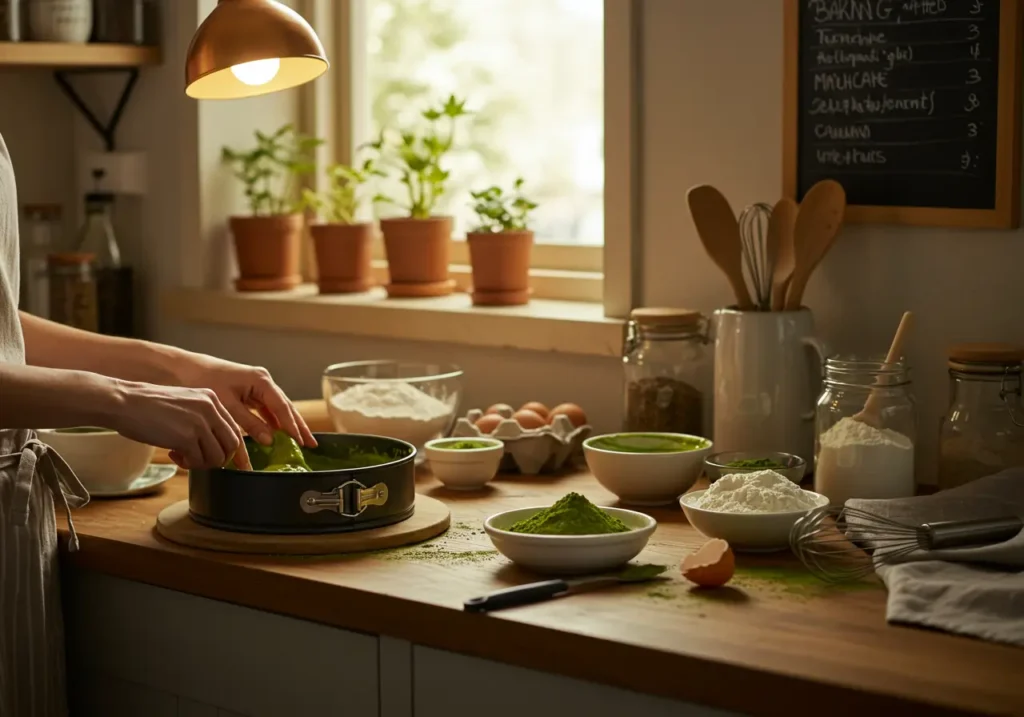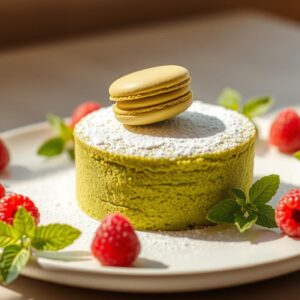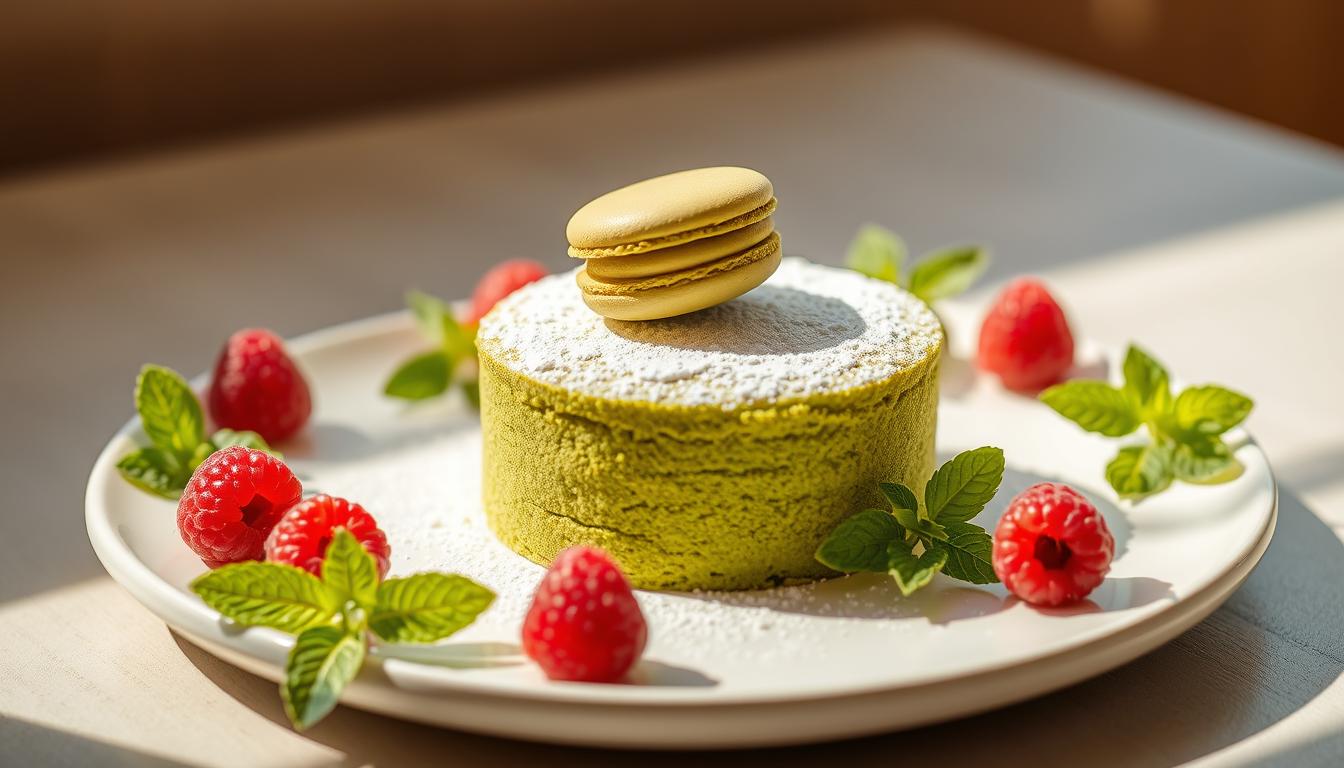Matcha Cake: 3 Proven Secrets for Perfect Baking
Are you ready to enjoy the special taste and health perks of green tea in a sweet treat? Making a matcha dessert at home can be very rewarding. With the right tips, you can make a truly amazing dessert.
Online, you’ll find many recipes, both vegan and non-vegan. Each one has its own advice for getting the best matcha flavor. In this article, we’ll share the secrets to baking the best green tea cake you’ll ever have.
By the end of this article, you’ll know how to make a delicious matcha cake. It will surely impress your family and friends.
Table of Contents
The Magic of Matcha Cake: What Makes It Special
Matcha, with its rich history and cultural significance, adds a unique twist to traditional cake recipes. You might be wondering what sets matcha apart from other ingredients and why it’s become a staple in modern baking.
Understanding Matcha
What Makes Matcha Different from Regular Green Tea
Matcha is different from regular green tea because of how it’s grown and prepared. It’s grown in the shade, which makes it more vibrant and rich. This unique taste is a hallmark of high-quality matcha.
The Unique Flavor Profile of Matcha in Desserts
The flavor of matcha in desserts is special. It has a subtle bitterness and grassy undertones. These flavors mix well with sweet ingredients, making cakes refreshing and sophisticated. Culinary experts say, “matcha brings a depth of flavor to desserts that is hard to achieve with other ingredients.”
“Matcha is not just a flavor; it’s an experience. It elevates the simplicity of a cake to a new level of sophistication.”
Health Benefits of Incorporating Matcha in Your Baking
Adding matcha to your baking not only makes your desserts taste better but also makes them healthier. Matcha is full of antioxidants, vitamins, and minerals. It’s a healthier choice than traditional flavorings. By using matcha, you can make delicious and nutritious treats that everyone will enjoy.
Matcha’s unique flavor and health benefits make it a great choice for any cake recipe. Whether you’re making a japanese matcha cake, a matcha sponge cake, or a matcha cheesecake, using high-quality matcha powder is essential for the best results.
Secret #1: Selecting and Preparing the Perfect Matcha Powder
The journey to a perfect matcha cake starts with the right matcha powder. You need to know the different types and how to get them ready for baking.
Choosing Culinary-Grade vs. Ceremonial-Grade Matcha
For baking, culinary-grade matcha is best. It has a bold flavor that can mix well with other ingredients. Ceremonial-grade matcha is more delicate and used for tea ceremonies. Culinary-grade is better for baking because of its strong taste.
Here are key differences between culinary and ceremonial-grade matcha:
- Culinary-grade matcha has a bolder, more astringent taste.
- Ceremonial-grade matcha is smoother and more subtle.
- Culinary-grade is generally less expensive.
How to Properly Sift Matcha to Eliminate Clumps
Sifting matcha powder is key to avoid clumps in your batter. Use a fine-mesh sieve or small sifter. Gently tap the sieve to sift the matcha evenly. This makes sure the matcha is spread out in the cake, giving a consistent taste and color.
The Ideal Matcha-to-Flour Ratio for Balanced Flavor
Getting the right mix of matcha and flour is important for a tasty matcha cake. Use 1-2 teaspoons of matcha powder per 1 cup of flour. But, this can change based on your taste and the matcha type. It’s important to taste as you go and adjust the mix for the flavor you want.
Some tips for the perfect mix include:
- Start with a small amount of matcha and taste the batter.
- Adjust the amount based on your matcha flavor preference.
- Think about how other ingredients might change the matcha taste.
Secret #2: Mastering the Matcha Cake Batter Technique

Making a great matcha cake starts with the batter. A perfect batter is key to a tasty matcha dessert. Several things make it just right.
Why Room Temperature Ingredients Matter
Room temperature ingredients are vital for matcha cake batter. They help butter and eggs mix well, creating a smooth texture. This is important for the cake’s structure and rise.
Cold ingredients can make the cake dense or uneven. This ruins the joy of eating a green tea cake.
Culinary experts say, “The temperature of your ingredients can significantly affect the final texture of your cake.”
“If your ingredients are not at room temperature, the batter may not emulsify properly, leading to an undesirable texture in the finished cake.”
Mixing Methods That Preserve Matcha’s Vibrant Color
The bright green color of matcha is beautiful. To keep this color, mix the batter gently. Avoid overmixing, which can make the matcha lose its color.
Achieving the Perfect Batter Consistency Every Time
Getting the batter just right is essential for a matcha cake. It should be smooth and not too thick or thin. Check by lifting some batter with a spatula; it should flow smoothly back into the bowl.
| Batter Consistency | Description | Result |
|---|---|---|
| Too Thick | Batter does not flow easily off the spatula | Dense cake |
| Too Thin | Batter flows too quickly, lacks structure | Flat or soggy cake |
| Perfect | Batter flows smoothly, steady stream | Light, fluffy cake |
Mastering the matcha cake batter technique ensures your green tea cake is delicious and looks great every time.
Secret #3: Baking Your Matcha Cake to Perfection

The secret to a perfect matcha cake is not just in the batter. It’s also in how you bake it. The right oven temperature and timing are key.
Optimal Oven Temperature and Rack Positioning
Getting your oven to the right temperature is essential. For matcha cakes, aim for 325°F to 350°F (165°C to 175°C). Place your rack in the center for even baking. Using an oven thermometer ensures your oven is at the correct temperature, as ovens can vary.
Timing Considerations for Different Cake Sizes and Pans
The size and type of pan affect baking time. A larger, shallower pan bakes faster than a smaller, deeper one. A standard 8-inch round cake usually bakes in 25-35 minutes. Always watch your cake as it nears the minimum baking time.
How to Test for Doneness Without Compromising Color
To check if your cake is done without losing its green color, press the top gently. It should spring back. Or, insert a toothpick into the center. If it comes out clean or with a few moist crumbs, it’s ready. Avoid overbaking to keep the cake moist and green.
Mastering these baking techniques will help you make a delicious and visually appealing matcha cake. Whether it’s a matcha sponge cake or a matcha cheesecake, these tips will guide you to perfection.
Enjoying Your Homemade Matcha Creation
Now that you’ve learned how to bake the best matcha cake at home, it’s time to enjoy it. Take a bite and savor the unique flavor and vibrant green color. Your homemade Japanese matcha cake is perfect as a dessert or snack.
Try out different matcha recipes to make your own special cake. The web is full of ideas for matcha desserts you can try. Each one is a chance to create something new and delicious.
As you keep baking and trying new things with matcha, you’ll find joy in making unique treats. These treats will surely impress your friends and family. So, get creative and enjoy making your perfect matcha cake.
FAQ
What is the difference between culinary-grade and ceremonial-grade matcha powder?
Culinary-grade matcha is great for baking because it’s more bitter. Ceremonial-grade matcha is perfect for tea ceremonies. It has a softer flavor and texture.
How do I properly store matcha powder to preserve its flavor and color?
Keep matcha powder in a sealed container. Place it away from sunlight, heat, and moisture. This keeps its green color and flavor fresh.
Can I substitute matcha powder with green tea leaves or green tea extract in matcha cake recipes?
No, matcha powder is special. It can’t be replaced by green tea leaves or extract. Use high-quality matcha for the best taste.
What is the ideal ratio of matcha to flour for a balanced flavor in matcha cake?
The right mix depends on what you like. Start with 1–2 teaspoons of matcha for every 1 1/2 cups of flour. Adjust to your taste.
How do I prevent matcha cake from becoming too dense or dry?
Use room temperature ingredients. Don’t overmix the batter. And don’t bake it too long. This keeps the cake moist and light.
Can I make matcha cake ahead of time, and if so, how should I store it?
Yes, you can make matcha cake ahead. Store it in a sealed container at room temperature or in the fridge. This keeps it fresh.
What are some variations I can try with matcha cake recipes, such as adding different flavors or ingredients?
Try adding white chocolate, strawberries, or nuts to your matcha cake. These can make unique and tasty variations.
How do I achieve a vibrant green color in my matcha cake?
For a bright green color, use top-quality matcha powder. Avoid mixing the batter too much. This helps keep the color vibrant.

Matcha Cake: 3 Proven Secrets for Perfect Baking
Equipment
- Mixing bowls
- Fine-mesh sieve for sifting matcha & flour
- Hand mixer or stand mixer
- Measuring cups & spoons
- Rubber spatula
- 8-inch round cake pan greased & lined
- Oven thermometer recommended
- Wire cooling rack
Ingredients
- 1 ½ cups 190 g all-purpose flour
- 1 –2 tsp high-quality culinary-grade matcha powder sifted
- 1 tsp baking powder
- ¼ tsp salt
- ½ cup 115 g unsalted butter, softened
- ¾ cup 150 g granulated sugar
- 3 large eggs room temperature
- ½ cup 120 ml milk (room temperature)
- 1 tsp vanilla extract
Optional Add-ins: white chocolate chips, strawberries, or chopped nuts.
Instructions
- Preheat Oven: Heat oven to 325–350°F (165–175°C). Place rack in the center. Grease & line an 8-inch cake pan.
- Sift Dry Ingredients: In a bowl, sift flour, matcha, baking powder, and salt. This removes clumps and evenly distributes matcha.
- Cream Butter & Sugar: In a large mixing bowl, beat softened butter and sugar until light and fluffy.
- Add Eggs: Add eggs one at a time, mixing well after each addition. Stir in vanilla extract.
- Combine Wet & Dry: Alternate adding dry ingredients and milk, beginning and ending with dry. Mix just until combined.
- Check Batter: Batter should be smooth and flow steadily from a spatula — not too thick or too runny.
- Bake: Pour batter into prepared pan. Bake 25–35 minutes, or until the cake springs back when lightly pressed and a toothpick comes out clean.
- Cool: Let cool in the pan for 10 minutes, then transfer to a wire rack to cool completely.
- Serve: Dust with extra matcha powder, top with whipped cream, or enjoy plain.
Did You Try Our Recipe?
There are no reviews yet. Be the first one to write one.

